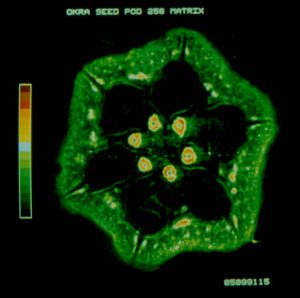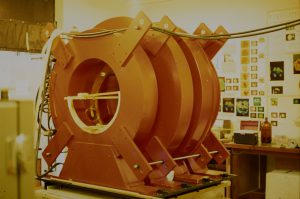October 21, 2019, by Kathryn Steenson
MRI Collections Project draws to a successful close
The MRI Collections Project, which Manuscripts and Special Collections (MSC) has been working on for the last 12 months, ended on 30 September. During this significant project, which was funded by a Wellcome Trust Research Resources award, MSC catalogued, preserved and selectively digitised the papers of the Nobel Prize winning physicist Professor Sir Peter Mansfield and two other scientists involved in the development of MRI at Nottingham, Professor Raymond Andrew and Professor Brian Worthington, together with associated records of the British Radiofrequency Spectroscopy Group (BRSG). The project team within MSC consisted of a Project Archivist, Archives Assistant and Digitisation Assistant.
Across all four collections, more than 5,000 catalogue records have been created as a result of the project. Also, all the material has been repackaged using archival quality materials into around 250 archive boxes. This is a fantastic achievement, and our thanks go to all those involved.
Another important part of the project was the digitisation of a huge number of 35 mm slides. Digital images of all the slides were produced by photographing them using a bespoke camera rig. The images were then assessed by project staff, and around 13,000 have been retained for the permanent collections. They include fascinating images of MRI scans of the human body, graphs of experimental results, and pictures of early MRI scanning equipment.
The collections also contain around 60 items of audio-visual material, such as videotapes in various formats, film reels and audio cassettes. This material has been digitised, to make access easier for researchers and to preserve these important recordings for the future. The recordings include footage of early experiments on Echo Planar Imaging, and of television programmes which featured the work of the MRI groups at Nottingham. It is particularly pleasing that Mansfield, Andrew and Worthington all feature in one or more of these recordings.
The three scientists’ collections are similar in several respects, the main one being that they all contain a substantial quantity of research papers. Those in the Mansfield collection generally relate directly to MRI research, whereas those in the Andrew collection are more concerned with nuclear magnetic resonance research and magic angle spinning (a technique which Andrew pioneered). Worthington’s collection covers the clinical applications of all kinds of medical imaging, including X-rays and CT scanning as well as MRI imaging. The large number of published academic papers in each collection reflects the fact that such ‘hard copy’ papers were the main source of reference material for academics in the pre-internet age.
One feature present in the Mansfield collection, but not in those of Andrew and Worthington, is the large quantity of papers relating to patents. Mansfield applied for a great many patents for his MRI-related inventions and techniques, and was vigorous in enforcing them.
Although the project has now ended, work on the MRI collections will continue! During the last 12 months we have received additional material from several sources, and we hope that further donations will occur in the future. We also plan to hold a research event in early 2020 at which academics can discover more about the collections. Cataloguing these papers has been fascinating, and we hope that our work will help to tell the thrilling story of the pioneering work on MRI which was undertaken in Nottingham, and which continues to the present day.
The MRI collections are now available for researchers to access in the Manuscripts and Special Collections Reading Room. To see them, please contact us to tell us what you would like to see and when you would like to visit. The catalogues for all the collections, namely those of Peter Mansfield, Brian Worthington, Raymond Andrew and the BRSG are also available online via the Manuscripts and Special Collections Online Catalogue.
No comments yet, fill out a comment to be the first



Leave a Reply